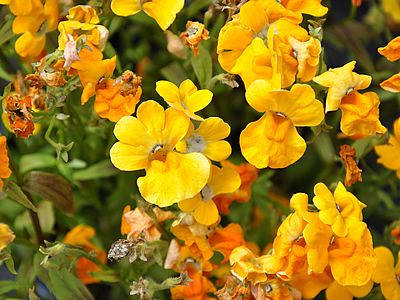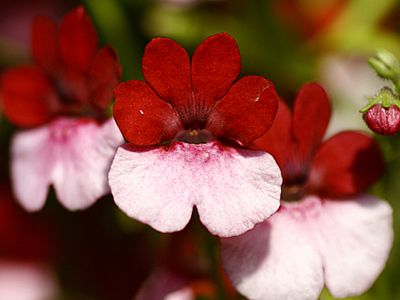The Cape Jewel (Nemesia strumosa) is a herbaceous, annual, and very floriferous plant native to sandy regions and temperate climates of South Africa. The Cape Jewel is a small plant that rarely exceeds 18 inches (45 centimeters) in height. Its branches sprout erect directly from the base, giving the plant a full and rounded shape. The leaves are simple, opposite, linear to lanceolate, and light green in color, with entire to serrated margins.
The inflorescences appear in summer and are of the raceme type, terminal, with delicately scented flowers. The flowers have a unique shape, consisting of a corolla with two petals, one upper divided into four lobes, and a large lower petal, split into two lobes, which often displays a color or hue different from the rest of the flower. Speaking of color, there are many options ranging from pink, yellow, orange, lilac, white, red, or blue. Many of these varieties are hybrids, produced through crossing with other species of the same genus, such as Nemesia versicolor, for example. Besides different colors, the cultivars result in plants with different sizes, hardiness, among other characteristics.

The Cape Jewel is perfect for colorful compositions, in mixtures of colors using only this plant or even with other species of annual flowers. Thus, it can be utilized in flower beds, borders, pots, planters, and hanging baskets. Prolong the flowering of the species by continuously removing old flowers. After a while, a more drastic pruning is also beneficial, stimulating a new and abundant flowering. Fertilize weekly with a good liquid fertilizer.
It can be grown in full sun, in cooler regions, or in partial shade, in very hot areas. The Cape Jewel prefers sandy, perfectly drainable soil, but well-enriched with organic matter, slightly acidic, and regularly watered. It does not tolerate drought, frost, or intense heat (above 84°F or 29°C).
Propagation is by seeds sown in autumn and winter in protected greenhouses so that they can be transplanted into flower beds in spring, after the last frost. Germination is completed in 14 to 20 days. It is also possible to propagate it by cutting the young branches that have not yet flowered. Encourage denser plant growth through the pinching technique.


